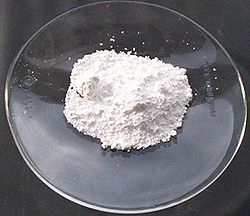Lead(II) sulfate
Chemical compound From Wikipedia, the free encyclopedia
Lead(II) sulfate (PbSO4) is a white solid, which appears white in microcrystalline form. It is also known as fast white, milk white, sulfuric acid lead salt or anglesite.
 | |
 | |
| Names | |
|---|---|
| IUPAC name
lead(II) sulfate | |
| Other names
Anglesite, fast white, milk white, plumbous sulfate | |
| Identifiers | |
3D model (JSmol) |
|
| ChemSpider | |
| ECHA InfoCard | 100.028.362 |
| EC Number |
|
PubChem CID |
|
| UNII | |
| UN number | 1759 1794 |
CompTox Dashboard (EPA) |
|
| |
| |
| Properties | |
| PbSO4 | |
| Molar mass | 303.26 g/mol[1][2] |
| Appearance | white solid |
| Density | 6.29 g/cm3[3] |
| Melting point | 1,087 °C (1,989 °F; 1,360 K) decomposes |
| 0.0032 g/100 mL (15 °C) 0.0404 g/100 mL (25 °C)[4] | |
Solubility product (Ksp) |
2.13 x 10−8 (20 °C) |
| Solubility | insoluble in alcohol
soluble in ammonium acetate (≥ 6 mol/L) soluble in ammonium tartrate in presence of ammonium chloride and ammonia |
| −69.7·10−6 cm3/mol | |
Refractive index (nD) |
1.877 |
| Structure | |
| orthorhombic, barite | |
| Thermochemistry | |
Heat capacity (C) |
103 J/degree mol |
Std molar entropy (S⦵298) |
149 J·mol−1·K−1[5] |
Std enthalpy of formation (ΔfH⦵298) |
−920 kJ·mol−1[5] |
| Hazards | |
| GHS labelling: | |
   | |
| Danger | |
| H302, H332, H360Df, H410 | |
| P201, P202, P260, P261, P264, P270, P271, P273, P281, P301+P312, P304+P312, P304+P340, P308+P313, P312, P314, P330, P391, P405, P501 | |
| NFPA 704 (fire diamond) | |
| Flash point | Non-flammable |
Threshold limit value (TLV) |
0.15 mg/m3 |
| Related compounds | |
Other anions |
Lead(II) chloride, Lead(II) bromide, Lead(II) iodide, Lead(II) fluoride |
Other cations |
Tin(II) sulfate, Sodium sulfate, Copper(II) sulfate |
Except where otherwise noted, data are given for materials in their standard state (at 25 °C [77 °F], 100 kPa).
| |
It is often seen in the plates/electrodes of car batteries, as it is formed when the battery is discharged (when the battery is recharged, then the lead sulfate is transformed back to metallic lead and sulfuric acid on the negative terminal or lead dioxide and sulfuric acid on the positive terminal). Lead sulfate is poorly soluble in water.
Structure
Anglesite (lead(II) sulfate, PbSO4) adopts the same orthorhombic crystal structure as celestite (strontium sulfate, SrSO4) and barite (barium sulfate, BaSO4). All three minerals' structures are in the space group Pbnm (number 62).[6] Each lead(II) ion is surrounded by 12 oxygen atoms from 7 sulfate ions, forming a PbO12 polyhedron.[7] The lead–oxygen distances range from 2.612 Å to 3.267 Å and the average distance is 2.865 Å.[6]
| Lead coordination | Sulfate coordination |
|---|---|
 |
 |
Manufacturing
Lead(II) sulfate is prepared by treating lead oxide, hydroxide or carbonate with warm sulfuric acid or by treating a soluble lead salt with sulfuric acid.
Alternatively, it can be made by the interaction of solutions of lead nitrate and sodium sulfate.
Toxicology
Lead sulfate is toxic by inhalation, ingestion and skin contact. It is a cumulative poison, and repeated exposure may lead to anemia, kidney damage, eyesight damage or damage to the central nervous system (especially in children). It is also corrosive - contact with the eyes can lead to severe irritation or burns. Typical threshold limit value is 0.15 mg/m3.
Mineral
The naturally occurring mineral anglesite, PbSO4, occurs as an oxidation product of primary lead sulfide ore,
Basic and hydrogen lead sulfates
A number of lead basic sulfates are known: PbSO4·PbO; PbSO4·2PbO; PbSO4·3PbO; PbSO4·4PbO. They are used in manufacturing of active paste for lead–acid batteries. A related mineral is leadhillite, 2PbCO3·PbSO4·Pb(OH)2.
At high concentration of sulfuric acid (>80%), lead hydrogensulfate, Pb(HSO4)2, forms.[8]
Chemical properties
Lead(II) sulfate can be dissolved in concentrated HNO3, HCl, H2SO4 producing acidic salts or complex compounds, and in concentrated alkali giving soluble tetrahydroxidoplumbate(II) [Pb(OH)4]2− complexes.
- PbSO4(s) + H2SO4(l) ⇌ Pb(HSO4)2(aq)
- PbSO4(s) + 4 NaOH(aq) → Na2[Pb(OH)4](aq) + Na2SO4(aq)
Lead(II) sulfate decomposes when heated above 1000 °C:
- PbSO4(s) → PbO(s) + SO3(g)
Applications
- Lead-acid storage batteries[9]
- Paint pigments[9]
- Laboratory reagent[9]
See also
References
External links
Wikiwand - on
Seamless Wikipedia browsing. On steroids.

